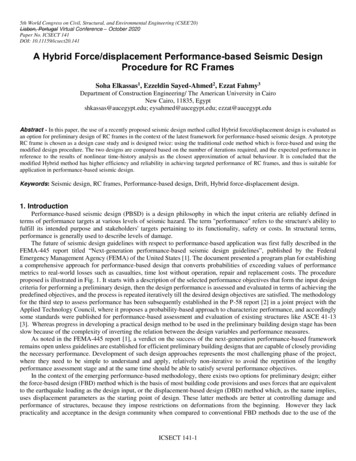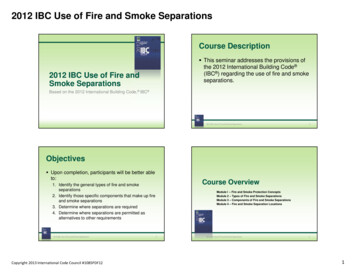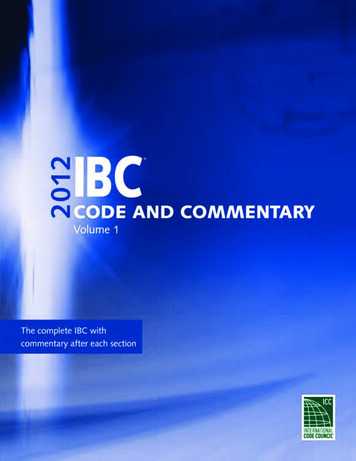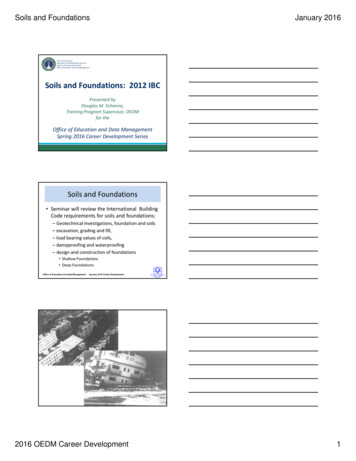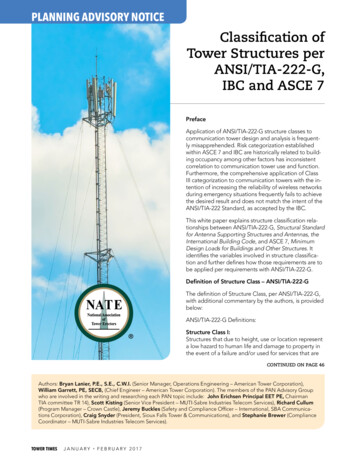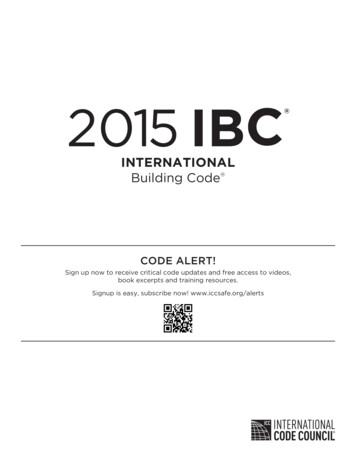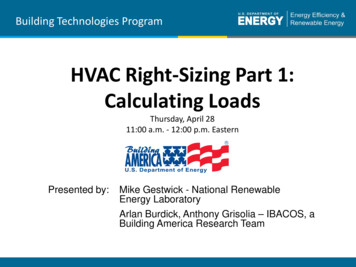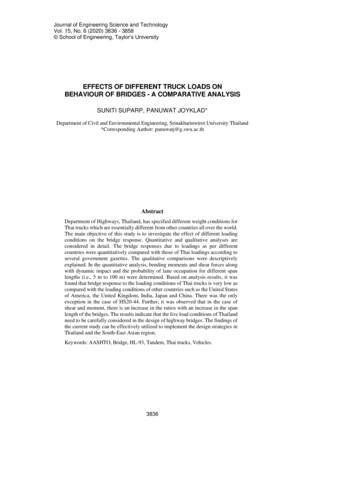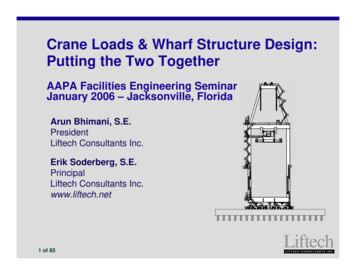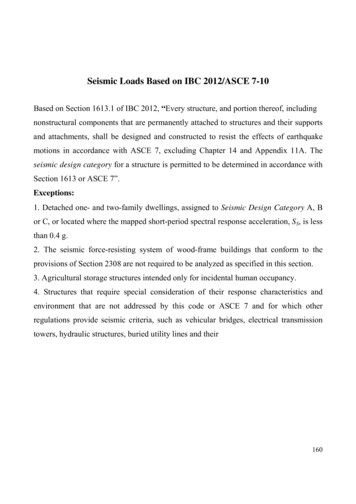
Transcription
Seismic Loads Based on IBC 2012/ASCE 7-10Based on Section 1613.1 of IBC 2012, “Every structure, and portion thereof, includingnonstructural components that are permanently attached to structures and their supportsand attachments, shall be designed and constructed to resist the effects of earthquakemotions in accordance with ASCE 7, excluding Chapter 14 and Appendix 11A. Theseismic design category for a structure is permitted to be determined in accordance withSection 1613 or ASCE 7”.Exceptions:1. Detached one- and two-family dwellings, assigned to Seismic Design Category A, Bor C, or located where the mapped short-period spectral response acceleration, SS, is lessthan 0.4 g.2. The seismic force-resisting system of wood-frame buildings that conform to theprovisions of Section 2308 are not required to be analyzed as specified in this section.3. Agricultural storage structures intended only for incidental human occupancy.4. Structures that require special consideration of their response characteristics andenvironment that are not addressed by this code or ASCE 7 and for which otherregulations provide seismic criteria, such as vehicular bridges, electrical transmissiontowers, hydraulic structures, buried utility lines and their160
Analysis Procedure1- Determination of maximum considered earthquake and design spectral responseaccelerations: Determine the mapped maximum considered earthquake MCE spectral responseaccelerations, S s for short period (0.2 sec.) and S1 for long period (1.0 sec.) usingthe spectral acceleration maps in IBC Figures 1613.3.1(1) through 1613.3.1(6).Where S1 is less than or equal to 0.04 and S s is less than or equal to 0.15, thestructure is permitted to be assigned to Seismic Design Category A. Determine the site class based on the soil properties. The site shall be classified asSite Class A, B, C, D, E or F in accordance with Chapter 20 of ASCE 7. Wherethe soil properties are not known in sufficient detail to determine the site class,Site Class D shall be used unless the building official or geotechnical datadetermines Site Class E or F soils are present at the site. Determine the maximum considered earthquake spectral response accelerationsadjusted for site class effects, S MS at short period and S M 1 at long period inaccordance with IBC 1613.3.3.S MS Fa S sS M 1 Fv S1where:Fa Site coefficient defined in IBC Table 1613.3.3(1).Fv Site coefficient defined in IBC Table 1613.3.3(2).161
Determine the 5% damped design spectral response accelerations S DS at shortperiod and S D1 at long period in accordance with IBC 1613.3.4.S DS (2 / 3) S MSS D1 (2 / 3) S M 1where:S MS The maximum considered earthquake spectral response accelerations forSM 1short period as determined in section 1613.3.3. The maximum considered earthquake spectral response accelerations forlong period as determined in section 1613.3.3.2- Determination of seismic design category and Importance factor:Risk categories of buildings and other structures are shown in IBC Table 1604.5.Importance factors, Ie , are shown in ASCE 7-10 Table 1.5-2. Structures classified asRisk Category I, II or III that are located where the mapped spectral responseacceleration parameter at 1-second period, S1 , is greater than or equal to 0.75 shall beassigned to Seismic Design Category E. Structures classified as Risk Category IV thatare located where the mapped spectral response acceleration parameterat 1-second period, S1 , is greater than or equal to 0.75 shall be assigned to SeismicDesign Category F. All other structures shall be assigned to a seismic design categorybased on their risk category and the design spectral response acceleration parameters,162
S DS and S D1 , determined in accordance with Section 1613.3.4 or the site-specificprocedures of ASCE 7. Each building and structure shall be assigned to the more severeseismic design category in accordance with Table 1613.3.5(1) or 1613.5.5(2),irrespective of the fundamental period of vibration of the structure.163
3- Determination of the Seismic Base Shear:The structural analysis shall consist of one of the types permitted in ASCE 7-10 Table12.6-1, based on the structure’s seismic design category, structural system, dynamicproperties, and regularity, or with the approval of the authority having jurisdiction, analternative generally accepted procedure is permitted to be used. The analysis procedureselected shall be completed in accordance with the requirements of the correspondingsection referenced in Table 12.6-1.164
165
3.1 Equivalent Lateral Force Analysis:Section 12.8 of ASCE 7-10 shall be used. The seismic base shear V in a given direction is determined in accordance withthe following equation:V Cs Wwhere:W effective seismic weightThe effective seismic weight, W, of a structure shall include the dead load above thebase and other loads above the base as listed below:1. In areas used for storage, a minimum of 25 percent of the floor live load shall beincluded.Exceptionsa. Where the inclusion of storage loads adds no more than 5% to the effective seismicweight at that level, it need not be included in the effective seismic weight.b. Floor live load in public garages and open parking structures need not be included.2. Where provision for partitions is required in the floor load design, the actualpartition weight or a minimum weight of 0.48 kN/m2 of floor area, whichever isgreater.3. Total operating weight of permanent equipment.Cs Seismic response coefficient S DS(R / I e )R response modification factor, given in ASCE 7-10 Table 12.2-1I e importance factorThe value of Cs shall not exceed the following:Cs S D1for T TLT (R / I e )166
Cs S D1 TLfor T TLT (R / I e )2The value of Cs shall not be less than:Cs 0.044 S DS I e 0.01For structures located where S1 is equal to or greater than 0.6g, Cs shall not be less thanCs 0.5 S1(R / I e )where:T fundamental period of the structureTL long-period transition period, (given in ASCE 7-10 Figure 22), which is thetransition period between the velocity and displacement-controlled portions of thedesign spectrum (about 5 seconds for Gaza Strip).An approximate value of Ta may be obtained from:Ta Ct hnxwhere:hn height of the building above the base in metersCt building period coefficient given in Table 12.8-2x constant given in Table 12.8-2The calculated fundamental period, T , cannot exceed the product of the coefficient, Cu ,in Table 12.8-1 times the approximate fundamental period, Ta .167
Table 12.8-1: Coefficient for upper limit on calculated periodDesign Spectral Response, S D1 0. 40.30.20.15 0.1Coefficient Cu1.41.41.51.61.7In cases where moment resisting frames do not exceed twelve stories in height andhaving a minimum story height of 3 m, an approximate period Ta in seconds in thefollowing form can be used:Ta 0.1 Nwhere N number of stories above the base168
3.2 Vertical Distribution of Seismic Forces:Fx Cvx VFandCvx wx hxkFn wi 1hiwnkwxhiFhw1hwhere:Fx Lateral force at level xCvx Vertical distribution factorV total design lateral force or shear at the base of the buildingwx and wi the portions of W assigned to levels x and ihx and hi heights to levels x and ik a distribution exponent related to the building period as follows:k 1 for buildings with T less than or equal to 0.5 secondsk 2 for buildings with T more than or equal to 2.5 secondsInterpolate between k 1 and k 2 for buildings with T between 0.5 and 2.53.3 Horizontal Distribution of Forces and Torsion:Horizontally distribute the shear VxxVx Fii 1where:Fi portion of the seismic base shear, V , introduced at leveliAccidental Torsion, M taM ta Vx (0.05 B )Total Torsion, M T M T M t M ta169
3.4 Story Drift:The story drift, , is defined as the difference between the deflection of the center ofmass at the top and bottom of the story being considered.δx Cd δ xeIeWhere:Cd deflection amplification factor, given in Table 12.2-1δ xe deflection determined by elastic analysis170
171
172
173
174
175
4- Seismic Load Effects and Combinations:4.1 Seismic Load EffectUse E ρ QE 0.2 S DS D for these combinationsUse E ρ QE 0.2 S DS D for these combinationsThe vertical seismic load effect, S DS , is permitted to be taken as zero when SDs is equalto or less than 0.125.4.2 Load Effect with Over-strength Factor176
4.3 Redundancy: The value of ρ is permitted to equal 1.0 for the following:1. Structures assigned to Seismic Design Category B or C.2. Drift calculation and P-delta effects.3. Design of collector elements.4. Design of members or connections where the seismic load effects including overstrength factor are required for design.5. Diaphragm loads. For structures assigned to Seismic Design Category D, E, or F, ρ shall equal 1.3unless one of the following two conditions is met, whereby ρ is permitted to betaken as 1.0:a. Each story resisting more than 35 percent of the base shear in the direction of interestshall comply with Table 12.3-3.b. Structures that are regular in plan at all levels provided that the seismic force-resistingsystems consist of at least two bays of seismic force-resisting perimeter framing on eachside of the structure in each orthogonal direction at each story resisting more than 35percent of the base shear. The number of bays for a shear wall shall be calculated as thelength of shear wall divided by the story height or two times the length of shear walldivided by the story height, hsx , for light-frame construction.177
Example (8):For the building shown in Example (1), using IBC 2012/ASCE 7-10, evaluate the forcesat the floor levels perpendicular to axes 1-1, 2-2, 3-3 and 4-4.Note that site class is D, S s 0.25 g and S1 0.10 g .Solution: Using Tables 1613.3.3(1) and 1613.3.3(2), short-period site coefficient Fa 1.60and long-period site coefficient Fv 2.40 . Maximum considered earthquake spectral response accelerations adjusted for siteclass effects are evaluated.S MS Fa S s 1.60 (0.25 g ) 0.4 gandS M 1 Fv S1 2.40 (0.10 g ) 0.24 g The 5% damped design spectral response accelerations S DS at short period andS D1 at long period in accordance are evaluated.22S DS S MS (0.40 g ) 0.267 g3322S D1 S M 1 (0.24 g ) 0.16 g33 Occupancy importance factor, I e 1.0 as evaluated from IBC 2012 Table 1604.5and ASCE 7-10 Table 1604.5. From Table 1613.3.5(1) and for S DS 0.267 g , Seismic Design Category (SDC) isB. For S D1 0.16 g and using Table 1613.3.5(2), SDC is C. Therefore, seismicdesign category (SDC) is “C”. For ordinary shear walls and using ASCE 7-10 Table 12.2-1, responsemodification coefficient R 5.0 . The seismic base shear V in a given direction is determined in accordance withthe following equation:V Cs WCs S DSS D1 (R / I e )T (R / I e ) 0.044 S DS I e 0.01Approximate period Ta 0.049 (21)0.75 0.48 sec .Cu Ta 1.58 (0.48) 0.758 sec . 0.48 sec.178
Cs 0.2670.16 0.0534 0.0667 0.044 (0.267 )5.0(5.0) (0.48)O.Ki.e., C s 0.0534The seismic base shear V 0.0534 (1814.4) 96.89 tons Vertical distribution of forces:w x hxFx Cvx V and Cvx kn wi 1ihk iK 1.038 (from linear interpolation).xShear forces Vx Fii 1Vertical Distribution of Forces:hxwx (hx 956.092.670.650 1814.401400.321.0096.89Level179
Seismic Loads Based on IBC 2012/ASCE 7-10 Based on Section 1613.1 of IBC 2012, “Every structure, and portion thereof, including nonstructural components that are permanently attached to structures and their supports and attachments, shall be designed and constructed to File Size: 1MBPage Count: 20
